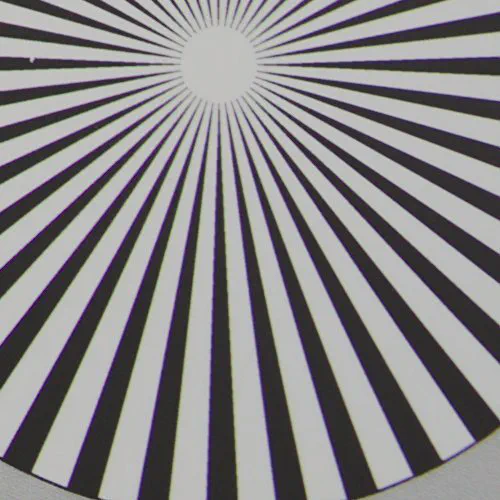Sigma 50mm f/2.8 Macro Review
- Nathaniel Stephan
- April 21, 2019

Table of Contents
The Sigma 50mm f2.8 macro lens can be difficult to find. I think this is due, in part, to the poor build quality. It is surprising to find old manual focus Sigma lenses in good condition.
My copy has a Nikon F mount, but it was made with other camera mounts.
Image quality is similar to other macro lenses from the late 1970s and 1980s. It likely shares one of the two optical designs used in the alternative macro lenses. My guess is that the lens has 5 or 6 elements.
Good luck trying to find a copy of the lens. Even if you were able to, the Komine made Vivitar 55mm f/2.8 is optically better and less expensive.
Lens Design
The front element is located towards the front of the lens. There are no floating elements. Focusing the lens causes all of the elements to move together. At 1:1 magnification the lens is front heavy.
Depending on the lighting, a lens hood will be needed. Any 52mm screw-on lens hood will work.
The aperture ring is plastic. There are half stops between what is marked on the ring.
There is 270 degrees of travel in the focus ring. Focus distance and magnification ratios are printed on the focus ring. There’s also a rubber grip.
The front element is located at the front of the lens. A 52mm screw-on lens hood will be helpful in lighting situations that are likely to cause glare.

Build Quality
First party lenses by Nikon, Canon, Minolta, and Olympus all have higher build qualities. Other than the serial number, all of the text on the lens has been printed instead of being engraved. The plastic aperture ring is particularly bad.
1980’s Sigma lenses have not impressed me. When I come across them, I expect something to be wrong. Common issues are fungus, balsam separation, oily aperture blades, and dried up helicoid grease.

Usage & Working Distance
I hate the aperture ring on the lens. It feels slightly “sticky,” requiring more force to turn than with other lenses. There is some kind of pattern on the ring, but it is not easy to grip. As a result, I was never confident that I could turn the ring to my desired aperture.
Overall, it is the worst aperture ring I have used. The second worst would be on the Minolta MD 50mm f/3.5 macro lens.
The focus ring was adequate. Many lenses have better ones, but it wasn’t notably bad.
At 1:1 the working distance is 5cm (1-15/16"). If I want 1:1 magnification I prefer a 90-105mm macro lens. Where the lens worked out well was on my copy stand.

Test Shot Sharpness Comparison
- f/2.8 - Blurry in the center with some chromatic aberration in the corners.
- f/4 - Still not sharp. There is less chromatic aberration in the corners.
- f/5.6 - The center is sharp. The edges of the corners are soft. No signs of chromatic aberration.
- f/8 - Sharpest aperture. The entire image is sharp.
- f/11 - Close to f/8. There is a small amount of detail loss as diffraction is beginning.
- f/16 & f/22 - Diffraction has set in.


Other Test Shots
I used the lens to copy a Durst M605 enlarger manual. Using Tesseract OCR, I turned the images into a searchable PDF. You can see the results here.
Life-Size Magnification

Lens Specifications
| Manufacture | Sigma |
| Made in | Japan |
| Year Released | 19?? |
| Original Price | $???.?? |
| Elements Groups | ? ele. ? gr. |
| Focal Length | 50mm |
| Aperture | f/2.8-22 |
| # Aperture Blades | 6 |
| Aperture Control | Manual |
| Focus Type | Manual |
| Hard Infinity Stop | Yes |
| Magnification | 1:1 |
| Minimum Focus Distance | 18cm (7”) |
| Working Distance | 5cm (1-15/16") |
| Filter Threads | 52mm |
| Weight | 344g (12.1oz) |
| Dimensions | ⌀67mm x 81mm (2.6 x 3.2") |
Sigma made the lens with Nikon F, Minolta MD, Canon FD, and Pentax K mount. Later versions of the lens were made for Canon EOS.
There are at least 2 versions of the lens with autofocus. They are labeled as AF, and AF DG.
Affiliate Advertising Disclosure
Outside the Shot is a participant in the Amazon Services LLC Associates Program, an affiliate advertising program designed to provide a means for sites to earn advertising fees by advertising and linking to Amazon.com.
As an eBay Partner, I may be compensated if you make a purchase. I also participate in affiliate advertising programs with KEH and Adorama. More can be found on the Affiliate Disclosure page.
Used prices on eBay
This is a hard lens to find. The only copies I was able to find were ones with a Pentax K mount.
That doesn’t mean you won’t find a lens with your desired mount. eBay is the best place to see the current prices and availability of this lens.
Later AF versions of the lens filled up the listings. Don’t expect to find more than one or two copies of the lens for sale.
Conclusion
The Sigma 50mm f/2.8 macro lens has mediocre optics at an above average price. At f/8, I wouldn’t be able to tell a difference between the other macro lenses I have tested. Other lenses that are similar in price are more enjoyable to use.
Don’t go hunting the lens down. The 55mm Vivitar is better in every regard, while costing less money.
Comparable Lenses
- Vivitar 55mm f/2.8 Macro - Available in several lens mounts.
- Olympus OM-System 50mm 3.5 Auto-Macro
- Micro Nikkor 55mm f/3.5 PC
- Canon FD Macro 50mm f/3.5


